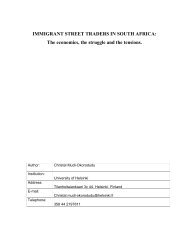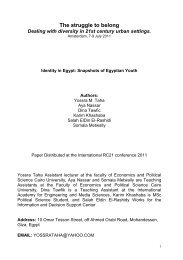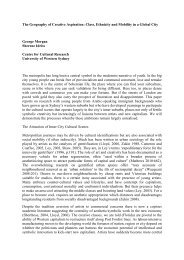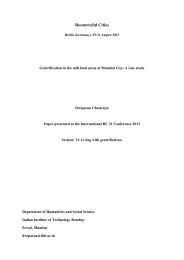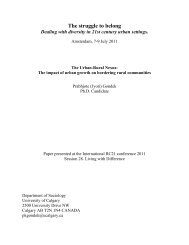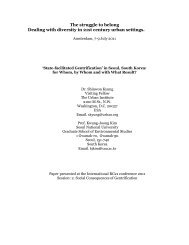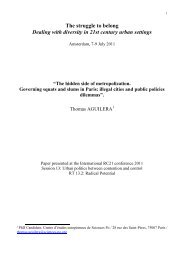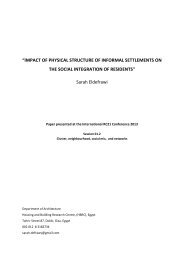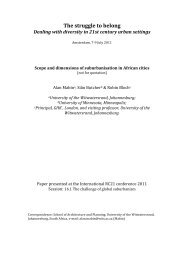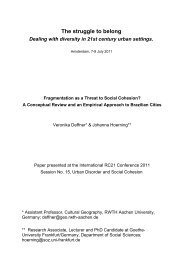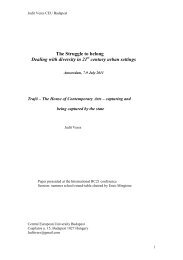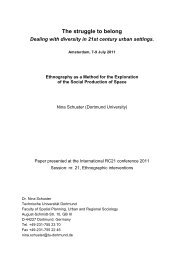White South Africans & The Experience of Gated Living in post ...
White South Africans & The Experience of Gated Living in post ...
White South Africans & The Experience of Gated Living in post ...
You also want an ePaper? Increase the reach of your titles
YUMPU automatically turns print PDFs into web optimized ePapers that Google loves.
community, and the desire for safety <strong>in</strong> America. One way she discovered <strong>in</strong> which white<br />
residents assuage their anxieties about race and crime is by polic<strong>in</strong>g the ‗niceness‘ <strong>of</strong><br />
other residents. <strong>The</strong> norm <strong>of</strong> ‗niceness‘ is a generic descriptor white residents use for<br />
what is judged as normal appearance and behavior. Low connects the construction <strong>of</strong><br />
‗niceness‘ to whiteness and contrast it to the ‗fear <strong>of</strong> others.‘ Norms <strong>in</strong> the social<br />
environment, she writes, ―act to naturalize the cultural preferences and codes <strong>of</strong> white<br />
privilege‖ and assuage the anxieties <strong>of</strong> white middle class.<br />
In her analysis <strong>of</strong> the different emotions residents experience, Low uses a psychoanalytic<br />
framework to expla<strong>in</strong> the experience <strong>of</strong> liv<strong>in</strong>g <strong>in</strong> gated communities. She builds on a<br />
small tradition <strong>in</strong> urban geography that has pioneered psychoanalytic accounts <strong>of</strong> the<br />
experience <strong>of</strong> space (Sennett 2008; Sibley 1995). <strong>South</strong> African researchers have also<br />
written <strong>in</strong> a psychoanalytic register. Bremner, for <strong>in</strong>stance, <strong>in</strong> her explanation <strong>of</strong> the<br />
phenomenon <strong>of</strong> gat<strong>in</strong>g argues that the impact <strong>of</strong> crime on the psyche <strong>of</strong> white <strong>South</strong><br />
<strong>Africans</strong> has the effect that (Bremner 2004):<br />
Ambiguities are elim<strong>in</strong>ated, new boundaries created and new social identities and certa<strong>in</strong>ties<br />
constructed (…) Crime provides a generative symbolism with which to talk about contemporary<br />
experiences perceived as alien, threaten<strong>in</strong>g, chaotic or bad – a black majority government ,<br />
deteriorat<strong>in</strong>g social services, dysfunctional traffic lights, a disloyal domestic worker etc. Through<br />
the experience <strong>of</strong> crime, uncomfortable processes <strong>of</strong> social change are coded and defensive<br />
mechanisms and projections aga<strong>in</strong>st them mobilized. Terror becomes the trope through which the<br />
transition is lived and made sense <strong>of</strong>.‖<br />
Bremner argues that the crim<strong>in</strong>al <strong>of</strong>fers a new imag<strong>in</strong>ary through which to establish<br />
cont<strong>in</strong>uity between the certa<strong>in</strong>ties <strong>of</strong> the past, the uncerta<strong>in</strong>ties <strong>of</strong> the present and the<br />
unknown-ness <strong>of</strong> the future. <strong>The</strong> wall <strong>of</strong> the gated community is the central figure <strong>of</strong> the<br />
new political order (Bremner 2004).<br />
<strong>The</strong>oretically, both Low and Bremner rely on the work <strong>of</strong> psychoanalyst Kle<strong>in</strong> to expla<strong>in</strong><br />
what they see as the contradictory values embodied by gated communities and the<br />
dom<strong>in</strong>ance <strong>of</strong> ‗terror‘ <strong>in</strong> the experience <strong>of</strong> whites. ii <strong>The</strong>y argue that racial anxieties and<br />
racialized fears about crime are so dom<strong>in</strong>ant among white residents that they have to rely<br />
on ‗code‘ to speak about their emotional experiences. In other words, that gat<strong>in</strong>g and fear<br />
<strong>of</strong> crime really stand <strong>in</strong> for someth<strong>in</strong>g else: racism. This is also the view <strong>of</strong> Lemanski. In<br />
a series <strong>of</strong> studies, mostly <strong>in</strong> and around Cape Town, Lemanski researched the residential<br />
strategies and social experience <strong>of</strong> crime among whites (Lemanski 2004; 2006a; 2006b;<br />
2006c). She shows how white residents <strong>in</strong> gated communities <strong>of</strong>ten mix fears <strong>of</strong> crime<br />
with broader fears regard<strong>in</strong>g the future <strong>of</strong> their western lifestyles <strong>in</strong> the new <strong>South</strong> Africa.<br />
Most whites, at least from 2003, did no longer feel safe <strong>in</strong> their residential area. In her<br />
research, Lemanski endorses the view that discourses on crime among whites are an<br />
acceptable discourse that serves as a code or pretext for talk about racist fears and ‗the<br />
other.‘<br />
In their approach, Low, Bremner, and Lemanski suggest that gated estates still function<br />
as historic urban communities with close social relationships, and that white residents<br />
have to talk <strong>in</strong> code to keep other groups/races out. Although it is misguided to suggest<br />
racism is not present, the question is do white elites really need such ‗racial cod<strong>in</strong>g‘ to<br />
3



